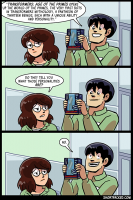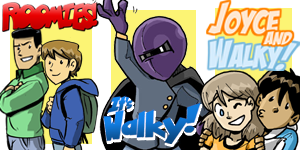Posted July 28, 2010 at 12:30 am

In 1994, Transformers was dead. Again! It died once in the United States (while it lingered overseas), and they tried bringing it back in 1993 with the original toys and characters. It didn't work. It was antiquated and it didn't speak to the new generation. Hasbro, who had recently acquired their former competitor Kenner, tossed them the rotting corpse of their once-golden property and told Kenner to have their way with it.
And for the first time in 10 years, Transformers was suddenly a top-selling toyline and a top-rated (Emmy award-winning) cartoon. The Beast Wars toys were the third-most popular boys toyline of its time, behind Power Rangers and Star Wars. The syndicated cartoon consistently ranked first in its local timeslot among the target demographic. It resurrected the Transformers franchise and saved it from the abyss. Why?
Because it was allowed to be different.

Some things that made Beast Wars popular were ganked from the Transformers franchise's recent history. Its incredible articulation, for one. Its willingness to resurrect older characters if needed. Its insistence on integrating weapons into the toys in both modes, so no accessories got left behind. But what it did innovate allowed Transformers to become a living, breathing, organic property. So to speak. Yes, everyone transformed into "real" animals. It was weird to the long-time fans, but it drew in children like crazy. For the longest time, Transformers had to be designed within a certain visual perimeter. Sort of Gundamy, sort of Robotechy... everyone had to have a normal face with a crest and maybe a visor, with blocky legs and arms. Beast Wars opened that up to toothy grins, bug eyes, and frightening mandibles. Sometimes arms ended in legs or claws. Sometimes feet didn't end in giant blocky boots, but in talons. Transformations were more complex and more creative. Shapes were new. Faces were new.
Transformers had become stale, and its near-death allowed the powers that be to unchain it, let it go, and let it find its own way, free of the conventional wisdom.

The cartoon benefited from a similar Renaissance. Bob Forward and Larry DiTillio, the co-story editors of Beast Wars, didn't know Transformers from a hole in the ground. But they knew how to write. And it turned out that was way more important. Financial and technological constrictions turned out to not be minuses, but pluses. Since Beast Wars was computer rendered, and this was 1995, the cast was tiny by necessity, starting with just five characters on each side, marooned on barren Earthlike planet. Instead of being agoraphobic, this allowed the writers to focus and explore the characters they had. Generation 1 started with 20 characters in its first season. By its second, there were more than 50. Some were lucky enough to get a line of dialog. A sparse few got spotlight episodes. But in Beast Wars, every character had time to shine. We knew these characters inside and out. They became real to us in ways that Transformers characters had rarely accomplished previously.

And it helped that Optimus Primal was not Optimus Prime. By the time we met Prime, he was already a fixture, a living legend. Inspirational to a child looking for a faultless father figure, but not very conducive to storytelling. When we met Primal, he was a nobody. He was new to his crew, and they to him. He made mistakes, but he was obviously learning on the job. And the rest of the cast knew it. Rattrap gave him so much grief. This was something rarely seen before, a hint of dissent within the good guy robots! The things Beast Wars introduced that we take for granted today...
Better yet, this was not the status quo. Rattrap organically learned to begrudgingly respect Primal. Dinobot learned over several seasons what his place in the universe was, and what he truly believed in, and what that meant for him. (It meant he would die.) Blackarachnia evolved from a by-the-numbers femme fatale into a compelling three-dimensional character. The show would always find a way to take away something from the characters that would show us who they are, allowing them to grow. In Blackarachnia's case, it was her autonomy. In Tigatron's case, it was his lover. In Dinobot's case, it was his certainty.
These things were made possible by the incredible caliber of writers assembled by Forward and DiTillio. Their ranks included Len Wein (creator of Wolverine, Storm, and Colossus), Christy Marx (Babylon 5), Jules Dennis (Real Ghostbusters and Batman: The Animated Series), D.C. Fontana (so much Star Trek), and, yes, Simon Furman (everything Transformers ever). For the first time, a Transformers show was allowed to have an over-arching plot from season to season, still with room for individual adventures. Transformers for the first time in animation was sophisticated, intelligent, and three-dimensional.

Some critics at the time of Beast Wars scoffed at its existence, claiming that once it was over it would return to obscurity, never to be seen or heard from again. They've been proven wrong repeatedly. The influence of Beast Wars persists to this very day. Transformers Animated gave us an Optimus Prime that was very much like the untested Optimus Primal, and included characters such as Rattletrap, Blackarachnia, and Waspinator. Beast Wars showed us that Transformers exists outside of the exclusive realm of the original cartoon, and incorporated elements taken from the Marvel Comics, like Primus, a concept that still informs Transformers fiction. The very idea of the spark, the tangible "soul" of a Transformer, has existed in every single incarnation of Transformers since, including the live-action movie, as has the concept of the Matrix/AllSpark as the Transformers afterlife. The cartoon set the golden standard for what Transformers television fiction should be and aspire to, according to both the fans and the creators of current Transformers content.
Beast Wars is why Transformers still exists. It pulled me back into Transformers after having left it, and is the biggest reason this very webcomic about toy collecting exists. It's informed my own storytelling in the past and will continue to inform it in the future. And there will always be a shelf in my house dedicated to its toys, as they portray a series of characters that will never, ever leave me. Characters that have taught me valuable things.
Beast Wars is awesome.
Tags: beast wars
Comments



